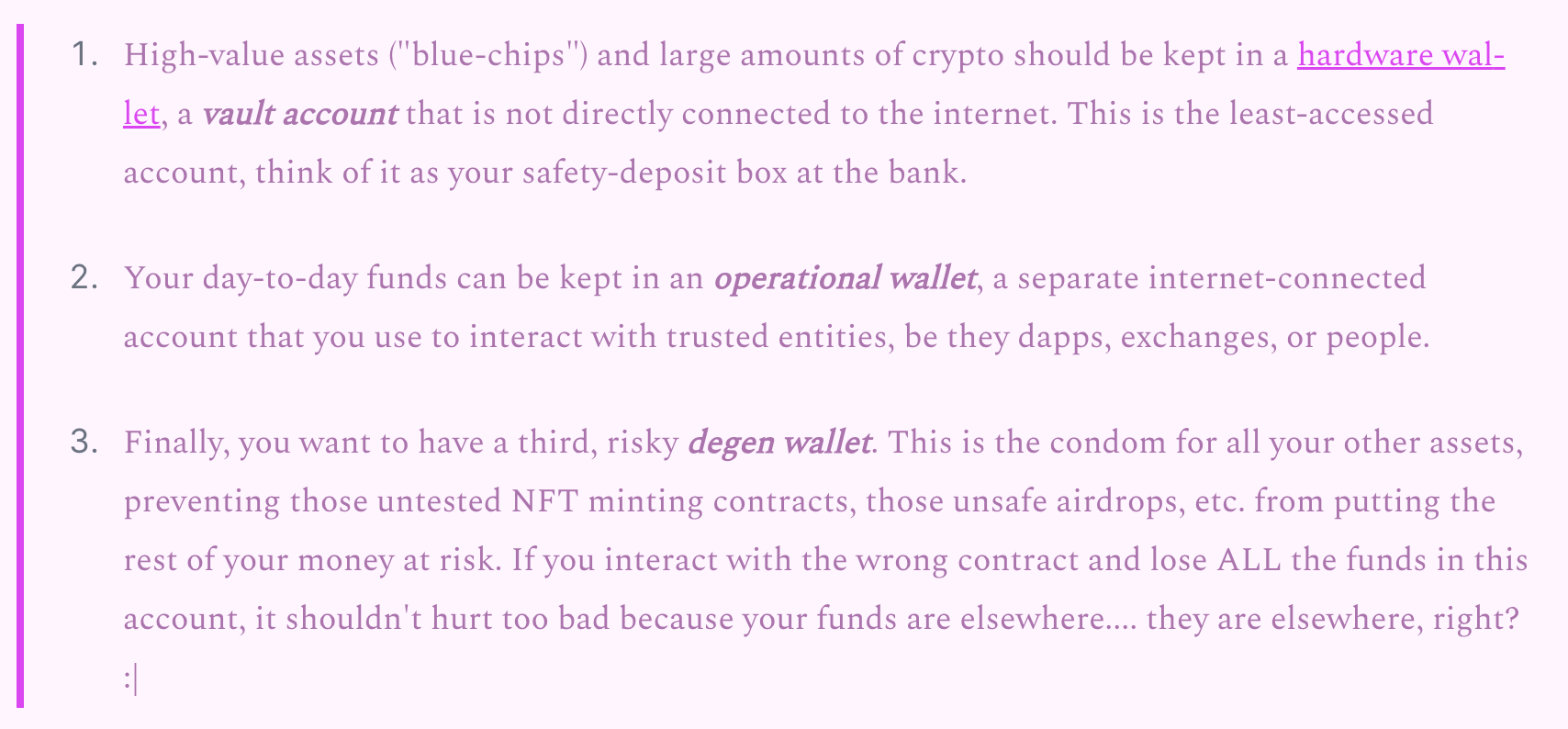Web3 wallets are like email addresses
In issue 24 we look at the importance of web3 wallets in the emerging onchain ecosystem, cover some wallet best practices, and guess at what a wallet-enabled future might look like.

Not that long ago, for many people a crypto wallet was something you opened or accessed every once in a while.
For most people, a crypto wallet is like a bank account or a credit card account. You might need to check a balance or perform a task occasionally, but you weren’t popping in and out of their wallets multiple times a day.
But all of that is changing, and changing fast.
As onchain activities like collecting, minting, following, signing, etc., are becoming more like everyday activities, accessing a web3 wallet is becoming as common as checking messages throughout the day.
With the utility of web3 wallets increasing rapidly, it seems like a good time to think through best wallet practices.

This week I participated in a Farcaster writing hackathon. I used the time to do something a little bit different and I wrote a personal essay. Also, it's the first piece I published onchain.
What is a web3 wallet?
A web3 wallet is like a crypto wallet in that it’s a place to send, receive, and hold digital assets. Most of the leading web3 wallet options are non-custodial, which means that you can control your private keys.
But beyond the basic functionality of sending and receiving supported crypto assets, web3 wallets layer in other functionality like acting as a digital identity or as a connection point to other web3 projects.
Sometimes wallets only support selected networks, so it’s always a good idea to check that the wallet you want to use is compatible with the network you plan to be active on.
Some of the important things that you need a web3 wallet for:
- collecting non-fungible tokens or NFTs, which can include art, collectibles, or even things like an ENS address
- connecting to web3-native apps and services such as Zora or Paragraph
- Signing transactions is a way of permitting something to happen like making a purchase
A simple way to think about a web3 wallet is like an email address but for onchain activities. It’s like a main hub where you can control digital assets, get notifications and subscriptions, and connect with others via supported clients.
Web3 wallet basics
The best way to understand web3 wallets is to just start using one.
Even though getting set up with a web3 wallet is becoming easier and easier and onboarding is pretty intuitive and straightforward (and made even simpler with the recent launch of smart wallets), there are still some best practices to keep in mind.
One practical tip is to start thinking about a simple wallet structure that will allow you to have a safe-keeping wallet, an identity or activity wallet, and then a wallet for risker or more speculative plays.
Here is a good overview of simple framework for good wallet safekeeping.

The takeaway here is that web3 wallets are interactive or more like a gateway than traditional crypto wallets. And since your wallet ID, like danielmcglynn.eth, could be available, it’s important to be mindful of scams and things like wallet phishing attempts.
Once you have a public web3 wallet ID, you will be amazed at some of the wallet spam that starts to show up.
Given the significant role that web3 wallets will play in the future of the onchain world, it is a little concerning that there are not a lot of wallet options.
So far Coinbase Wallet feels like the dominant wallet provider. While it is an easy-to-use option, it’s slightly concerning that we are watching another Google-like dominance situation starting to develop in the onchain world.
Hopefully, over time, more competitors and more web3 wallet options will emerge.
Web3 wallet as the connective tissue of the web3 experience
Web3 wallets are still kind of basic in a lot of ways.
I mean, it’s cool that you can collect, interact, and sign transactions with a web3 wallet. Sometimes, using a web3 wallet can feel a little bit like knowing a secret knock or the digital equivalent of getting into a speakeasy.
At the same time, sometimes using a web3 wallet doesn’t feel that different than some interactive web2 sign-in experiences.
Where things will get interesting is when communities and projects start to develop that only share info and content directly to a wallet address.
Another issue that feels like it will likely be solved at the wallet-level is web3 discovery.
Right now there are so many interesting projects and onchain native experiences that I would probably like to check out or be part of, but finding them and getting up to speed is difficult, mainly because of the time it takes for discovery or basic vetting.
I can imagine that someday my web3 wallet will become more like my Spotify account and start recommending onchain projects and activities based on my connections on previous activities.
If you are looking to get started with web3 or looking to do more or get more onchain, check out the free 5-day email course I put together. It will walk you through the basics in easy-to-digest lessons.